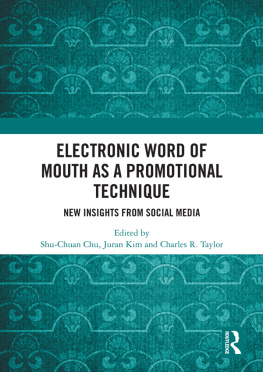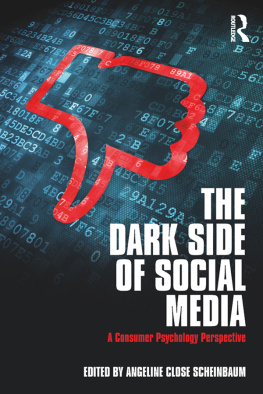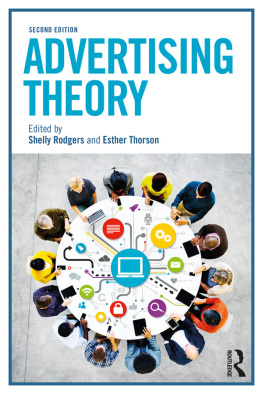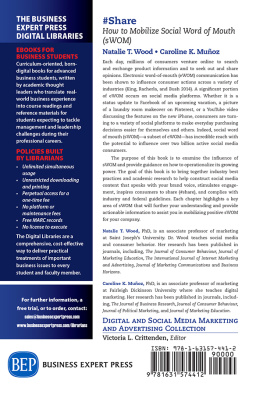Electronic Word of Mouth as a Promotional Technique
Recent years have seen digital advertising grow to the point where it will soon overtake television as the no. 1 advertising medium. In the online environment, consumers interact and share their thoughts on brands and their experiences using them. These electronic word-of-mouth (eWOM) communications have become very important to the success of products. In todays cluttered environment, it is especially important to study how the practice of eWOM advertising operates, and how marketers can influence eWOM in social media and other online sites.
This volume starts with a chapter on the current state of knowledge on eWOM and then turns its attention to current research articles on a variety of eWOM formats. These include the posting of selfies on social media, the influence of review types on consumer perception and purchase intention, the effects of preannouncement messages, and how user-generated content can be used to induce effectiveness of eWOM on social media. The relationship of eWOM to brand building is emphasized in several of the chapters.
This book was originally published as a special issue of the International Journal of Advertising.
Shu-Chuan Chu is an Associate Professor and Program Chair of Public Relations and Advertising in the College of Communication at DePaul University, Chicago, USA. Her research interests include social media, electronic word-of-mouth, and international advertising. Her work has been published in leading advertising and marketing journals.
Juran Kim is a Professor of Business Administration at Jeonju University, South Korea. She currently serves as the Associate Executive Secretary for the Global Alliance of Marketing and Management Scholars. Her work has appeared in the Journal of Advertising, International Journal of Advertising, Journal of Business Research, Journal of Consumer Mediate Communications, and several other leading publications.
Charles R. Taylor is the John A. Murphy Professor of Marketing at Villanova University, USA. He currently serves as the Editor-in-Chief of the International Journal of Advertising. He has published more than 100 peer-reviewed articles and has received the Ivan L. Preston and Flemming Hansen Awards for lifetime contribution to advertising research. He is a past President of the American Academy of Advertising.
First published 2019
by Routledge
2 Park Square, Milton Park, Abingdon, Oxon, OX14 4RN, UK
and by Routledge
52 Vanderbilt Avenue, New York, NY 10017, USA
Routledge is an imprint of the Taylor & Francis Group, an informa business
2019 Advertising Association
All rights reserved. No part of this book may be reprinted or reproduced or utilised in any form or by any electronic, mechanical, or other means, now known or hereafter invented, including photocopying and recording, or in any information storage or retrieval system, without permission in writing from the publishers.
Trademark notice: Product or corporate names may be trademarks or registered trademarks, and are used only for identification and explanation without intent to infringe.
British Library Cataloguing-in-Publication Data
A catalogue record for this book is available from the British Library
ISBN13: 978-1-138-36090-7
Typeset in Myriad Pro
by codeMantra
Publishers Note
The publisher accepts responsibility for any inconsistencies that may have arisen during the conversion of this book from journal articles to book chapters, namely the possible inclusion of journal terminology.
Disclaimer
Every effort has been made to contact copyright holders for their permission to reprint material in this book. The publishers would be grateful to hear from any copyright holder who is not here acknowledged and will undertake to rectify any errors or omissions in future editions of this book.
Contents
Shu-Chuan Chu and Juran Kim
Yongjun Sung, Eunice Kim and Sejung Marina Choi
Su Jung Kim, Ewa Maslowska and Edward C. Malthouse
Hao Zhang and Yung Kyun Choi
Jiye Shin, Heeju Chae and Eunju Ko
Yaeri Kim, Yookyung Park, Youseok Lee and Kiwan Park
Mikyoung Kim and Doori Song
Manu Bhandari and Shelly Rodgers
Jameson L. Hayes, Yan Shan and Karen Whitehill King
Guide
The chapters in this book were originally published in the International Journal of Advertising, volume 37, issue 1 (January 2018). When citing this material, please use the original page numbering for each article, as follows:
Chapter 1
The current state of knowledge on electronic word-of-mouth in advertising research
Shu-Chuan Chu and Juran Kim
International Journal of Advertising, volume 37, issue 1 (January 2018) pp. 113
Chapter 2
#Me and brands: understanding brand-selfie posters on social media
Yongjun Sung, Eunice Kim and Sejung Marina Choi
International Journal of Advertising, volume 37, issue 1 (January 2018) pp. 1428
Chapter 3
Understanding the effects of different review features on purchase probability
Su Jung Kim, Ewa Maslowska and Edward C. Malthouse
International Journal of Advertising, volume 37, issue 1 (January 2018) pp. 2953
Chapter 4
Preannouncement messages: impetus for electronic word-of-mouth
Hao Zhang and Yung Kyun Choi
International Journal of Advertising, volume 37, issue 1 (January 2018) pp. 5470
Chapter 5
The power of e-WOM using the hashtag: focusing on SNS advertising of SPA brands
Jiye Shin, Heeju Chae and Eunju Ko
International Journal of Advertising, volume 37, issue 1 (January 2018) pp. 7185
Chapter 6
Do we always adopt Facebook friends eWOM postings? The role of social identity and threat
Yaeri Kim, Yookyung Park, Youseok Lee and Kiwan Park
International Journal of Advertising, volume 37, issue 1 (January 2018) pp. 86104
Chapter 7
When brand-related UGC induces effectiveness on social media: the role of content sponsorship and content type
Mikyoung Kim and Doori Song
International Journal of Advertising, volume 37, issue 1 (January 2018) pp. 105124
Chapter 8
What does the brand say? Effects of brand feedback to negative eWOM on brand trust and purchase intentions
Manu Bhandari and Shelly Rodgers
International Journal of Advertising, volume 37, issue 1 (January 2018) pp. 125141
Chapter 9
The interconnected role of strength of brand and interpersonal relationships and user comment valence on brand video sharing behaviour
Jameson L. Hayes, Yan Shan and Karen Whitehill King
International Journal of Advertising, volume 37, issue 1 (January 2018) pp. 142164
For any permission-related enquiries please visit:
http://www.tandfonline.com/page/help/permissions
Manu Bhandari is an Assistant Professor of Strategic Communication in the Department of Communication at Arkansas State Universitys College of Liberal Arts and Communication, Jonesboro, USA. His research areas include online information processing and electronic word-of-mouth. At Arkansas State, he currently teaches courses in advertising principles, interactive advertising, and media writing.











![Eileen Brown [Eileen Brown] - Working the Crowd - Social media marketing for business Second edition](/uploads/posts/book/124044/thumbs/eileen-brown-eileen-brown-working-the-crowd.jpg)